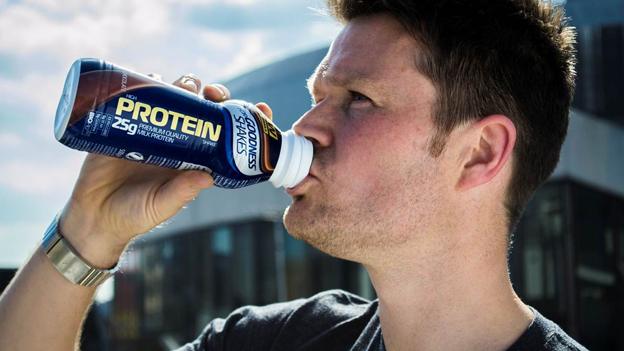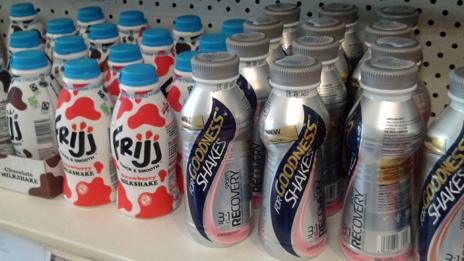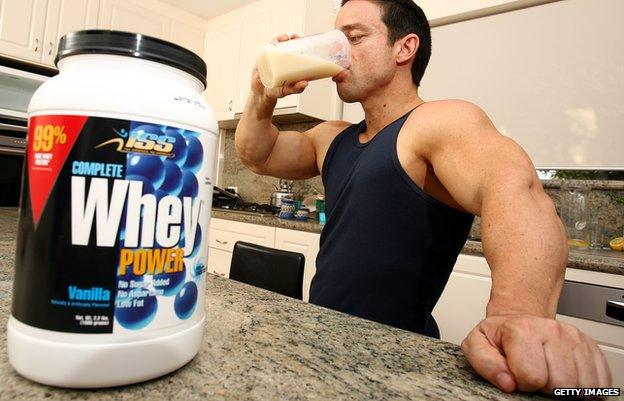The rise of the protein drinks for ordinary people
- Published

Protein products are increasingly being marketed in supermarkets to ordinary people. Do they serve any real purpose for non-athletes?
The "sport-related" protein product sector is booming. It's estimated that the world will be chewing and gulping down £8bn a year of bars, drinks, and other supplements by 2017.
But there's now a wave of products where the branding marks a departure from the traditional world of the protein supplement.
The classic protein drinks have usually been characterised by displays of over-sized bottles and tubs, often with labels depicting rippling torsos. The powders and bars targeted hardcore gym-goers and amateur athletes.
The typical customer was someone who wanted to build muscle and aid recovery after a serious workout.
But the latest generation is positioned more around healthy lifestyle.
In the UK, a "high protein dairy drink" called Upbeat is the latest product to get a big marketing push. It follows the path blazed by For Goodness Shakes, a drink primarily aimed at gym-goers and athletes that was picked up by a wider pool of buyers.
Similar lifestyle protein products can be seen in the US on the shelves of the likes of Wal-Mart, K-Mart, Walgreens, and CVS.
But there's an elephant in the room. People in the West usually already get more than enough protein.
Healthy protein intake depends on weight, with a recommended intake figure of 0.8g per kg of weight per day often cited. Age is also a factor. Over the course of a day, the average man should be eating around 55g of protein, while a woman needs 45g, says the British Dietetic Association. In the US, the national public health body, the Centers for Disease Control and Prevention, recommends, external 56g for an average man and 45g for a woman.
In the UK the mean intake for men is 86.5g per day, with women consuming 65g, says nutritionist Dr Helen Crawley. The CDC says "most adults in the United States get more than enough protein to meet their needs".
In the US, UK and most of the rest of the West people have diets that easily supply enough protein. A chicken breast might contain around 40g of protein, a cod fillet 30g, a helping of tofu 15g and an egg 6g.
Topping up with supplements can see substantial amounts of extra protein enter the diet, with some shakes offering up to 35g per serving.
Everybody needs protein in their diet on a daily basis as it is essential to body tissues, is necessary for growth and contributes to muscle mass and bone health.
But processing excess intake can put pressure on the kidneys, says Crawley. Excess animal protein is linked with kidney stones. In people with a pre-existing condition, excess protein can accelerate kidney disease, external.
Only vulnerable groups, such as those recovering from surgery or frail older people, tend to need more protein - something for which medical advice should be sought.
"There's no reason to have added protein in food, because we already have it," says Crawley.
There are those who advocate higher protein ratios in diets, arguing that the mainstream nutritional advice is outdated and that active people might need considerably more. Even the CDC allows a range of between 10-35% of daily calories coming from protein.

Protein shakes sit alongside regular milkshakes in the supermarket
So what is behind the appearance of the ever-expanding range of protein supplements?
An "extreme" group of athletes working out in gyms were the pioneers for the supplements' popularity, says Chris Schmidt, a research analyst at market research firm Euromonitor International.
The idea was that muscles damaged during intense weight training could be repaired and developed by turning dried and concentrated whey, a by-product of cheese-making, into a drink. These shakes were seen as more efficient and convenient than having to eat large amounts of high-protein foods.
Only a handful of specialist shops sold the powder and new customers were often found by targeting their personal trainers.
"In the early days they were very much associated with body building. Until the late 90s very few people outside that high performance athletic community had heard of them," says Schmidt.

The bodybuilders were followed by professional athletes, then amateur and college athletes.
"They turned into these lifelong users and that was a big part of what broke the stigma, because a guy from across the street used it, not some Arnold Schwarzenegger bodybuilding guy," says Schmidt.
As more people take an interest in their wellbeing - exercising more and eating more healthily - demand for protein rich products has continued to grow, says Schmidt.
The large tubs still exist, but more convenient ready-mixed shakes are now widely available, along with snack bars and flapjacks. Whey powders have also been joined by other protein sources including casein, hemp and rice.
The combined result has been a sharp increase in sales. According to Euromonitor figures worldwide sales of sports related protein products grew from £2.5bn in 2007 to £4.9bn in 2012 and are likely to reach £7.8bn in 2017. In the UK sales increased from £73m in 2007 to £170m in 2012 and are expected to reach £358m by 2017.
And the most notable part of the growth is the shift to marketing to "ordinary" people. Among new shakes is Wing-Co, a chocolate-flavoured high-protein drink aimed as a snack alternative for men in their 30s and 40s who "aren't sucked in by lots of marketing rubbish, external".
Upbeat drinks are pitched as a snack or breakfast replacement which might appeal to people including "post-pregnancy mums and vegetarians", external.
These are drinks which are being pitched at a "far broader more mainstream audience", says Julia Glotz, fresh food editor at The Grocer.
A lot of work has gone into the branding and the drinks look much more like other modern supermarket brands than sports supplements, says Glotz.
The new products aren't even marketed as "supplements". They might be a breakfast substitute for someone in a hurry, or pitched as an alternative to a snack.
They benefit from the general aura of healthiness that hovers over the word "protein". If protein is so healthy, and I want a snack, one that will fill me up, I might very well be drawn to something with protein written on the packet.
The trend, says Glotz, was started by For Goodness Shakes, which "still looked quite gym" but did not look out of place in the chiller cabinet. More have followed.
"You see a few of them in the food-to-go area, where they might be positioned as a particularly filling drink that you can have at lunchtime. And you also see some of them sitting in the milk drinks and milkshakes section."
Others have also spotted the possibilities. Danone makes a high protein yoghurt called Danio, while dieters might find themselves drawn towards Atkins chocolate bars and Marks and Spencer has a range of high protein meals that promise to keep you "fuller longer".
Protein supplements do have a place used once a day after muscle-building training, but most people - including regular gym goers - would find that milk contains the right combination of protein and carbohydrates for rehydration and repair, says Azmina Govindji of the British Dietetic Association.
The key is a balanced diet, but supplements can be attractive.
"It's in our nature to look for quick fixes, this is why diets work so well. If you're promised by the hype and the marketing that this particular shake will help you to build muscle, then these very compelling messages can be quite alluring."
But for many people using shakes and other supplements it's the convenience they offer - rather than the belief that they're an alternative to food - that is important, says Rob Aitken of personal trainers Matt Roberts.
"For up to two hours after a workout there's a window to aid recovery. At that time they may not want to sit down and have a full meal."
His clients are advised to try and eat protein with every meal and to make sure they combine shakes with real food.
"The clue is in the name, it's a supplement."
You can follow the Magazine on Twitter, external and on Facebook, external